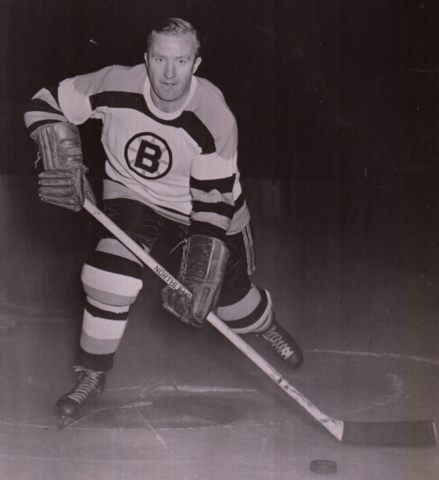IMAGE INFORMATION
EditHubert George "Bill" Quackenbush - Born March 2, 1922 in Toronto, Ontario – Died September 12, 1999 in Newtown, Pennsylvania was a Canadian professional ice Hockey defenceman and coach.
Quackenbush played Hockey on outdoor rinks around Toronto during the Great Depression as a youth, and was one of the top high school athletes in Canada as a teenager. In addition to Hockey, he was a renowned football and soccer player. During the War Years, he played for the famous Canadian soccer club Toronto Scottish.
Quackenbush had an opportunity to play football professionally, but he decided to pursue a career in Hockey.
Quackenbush began his junior career playing for the Toronto Native Sons of the Ontario Hockey Association. He scored 13 points in 13 games during the 1940–41 season. The following season, he played for the Brantford Lions, scoring 34 points in 23 games, where scout Carson Cooper noticed him the following year while he was playing with the Brantford Juniors under coach Tommy Ivan, who himself later became head coach of the Detroit Red Wings.
Quackenbush signed as a free-agent with the Detroit Red Wings on October 19, 1942, and played 10 games during the 1942–43 season before breaking his wrist. After recovering from the injury, Detroit assigned him to the American Hockey League where he joined the Indianapolis Capitals. He earned a regular position with the Red Wings during the 1943–44 season, scoring 4 goals and 18 points. In the next two seasons he averaged 21 points while only being assessed an average of 8 penalty minutes and scored a career high 11 goals in 1945–46. The following season he earned his first post-season honour, when he was named a Second Team NHL All-Star. He was also named the Red Wings team MVP.
Quackenbush registered a career high 17 penalty minutes in 1947–48 and was named a First Team All-Star. The season also saw the start of a streak of 131 consecutive games where Quackenbush was not assessed a penalty. It began with the final 5 regular season and 10 playoff games that year, continued through the entire 60 regular season and 11 playoff games during the 1948–49 season, and ended after 45 games of the 1949–50 season. At the conclusion of the 1948–49 season, he was awarded the Lady Byng Trophy, the NHL's annual award for sportsmanship and gentlemanly conduct. He was the first defenceman to win the award, and remains one of only three in NHL history to capture the trophy. During this penalty-free period, Quackenbush's regular defense partner was the equally mild-mannered Red Kelly, who later became the second rearguard to win the Lady Byng.
Detroit General Manager Jack Adams detested the award and felt that any player who won it did not belong on his team, so he promptly traded Quackenbush before the start of the next season. He was sent to the Boston Bruins with Pete Horeck for Pete Babando, Lloyd Durham, Clare Martin and Jimmy Peters, Sr.
Quackenbush became a fan favorite upon his arrival in Boston, where his offensive style of play was compared to former Bruin (and fellow Hall of Famer) Eddie Shore. In his first season in Boston, Quackenbush scored 8 goals and 25 points. He continued to stay out of the penalty box, registering only 4 penalty minutes. However, it marked the first time in three seasons that he was not named to the NHL All-Star Team. The Bruins defence core was depleted by injury in 1950–51, forcing the team to use several first year players. While this resulted in Quackenbush having to play more minutes, including a game where he played 55 minutes, it also gave him the opportunity to play with his brother Max. It was the only time the two played professionally together. He also set a career high in points with 29 and was again named a First Team NHL All-Star. Over the next five seasons Quackenbush hovered around the 20 point mark and was never assessed more than 8 penalty minutes in a year.
Quackenbush retired following the 1955–56 season, having accumulated only 95 penalty minutes over 774 games. This averaged out to seven seconds a game, one of the lowest in NHL history for a player at any position.
Following his NHL career, Quackenbush worked as a manufacturer's agent while attending night school at Northeastern University in Boston, Massachusetts. At Northeastern, he earned an Associate's degree in engineering. Quackenbush also became an assistant Hockey coach at Northeastern.
In 1967, he became the head coach for Princeton University's men's ice Hockey team, a position he would hold for six seasons. His best season was his first in 1967–68, when the Tigers posted a 13–10–0 record. It was the highest win total for Princeton since 1935–36. However, his success with the men's ice Hockey team would not last; Princeton won no more than five games for their next five seasons. His worst campaign was in 1970–71, when Princeton had two 11 game losing streaks and a 1–22–0 overall record. Because of this, Quackenbush stepped down as the head coach in 1973. In 1969 he began coaching the Princeton men's golf team. He enjoyed much greater success with the golf team, leading them to eight Ivy League championships.
In 1978 Princeton started a women's ice Hockey team, and Quackenbush was asked to coach them. He was still coaching the golf team but decided to accept the additional position and led them to three consecutive Ivy League championships between 1982 and 1984. Quackenbush retired from coaching in 1985.
Bill Quackenbush was inducted into the Hockey Hall of Fame in 1976.





































